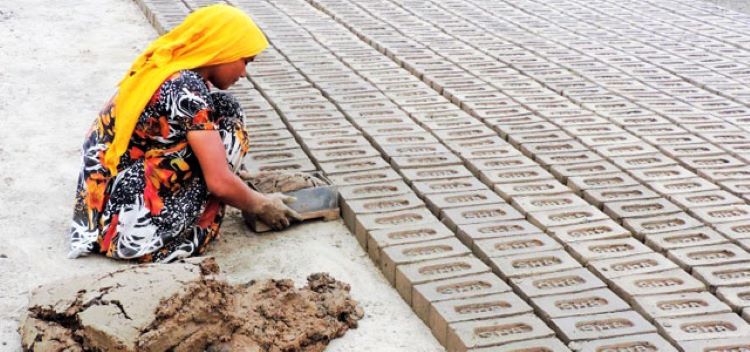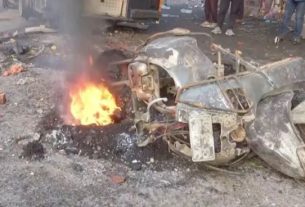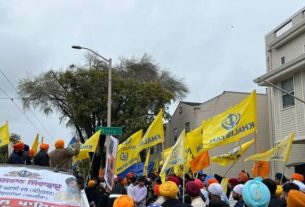by Bharat Dogra
In many villages of Banda district, Uttar Pradesh, livelihood conditions for many landless worker households and even for many marginal farmer households, those with very small and sometimes disputed land holdings, have become so precious that for almost nine months in a year they migrate to work in brick kilns of many distant places.
In the case of a typical such household, this migration is likely to start around the month of October and November while the return may take place around the month of July next year.
While leaving, a household is likely to get a lump sum of around Rs. 15,000 to Rs. 50,000 the bulk of which in turn is used for paying back, at least partially, some pending loan. If the migrating family is leaving behind some elderly members and small children with them, then it is likely that a part of the advance payment will be left with them. Hence the worker, his wife and adolescent/young children will leave with very little money in their own hands. In fact paying back the pending loan, generally only partially, may be the most important reason why the worker is so eager to get the advance.
While a truck collects many workers and worker households at a single village or collection point, they are likely to be dispersed at various different brick kilns. An isolated worker household in a brick kiln is almost completely at the mercy of the brick kiln owner or manager. While some of them may behave in a relatively better way, the more general experience of a worker household is likely to be that of exploitation at various levels.
The payment of a worker is often made on the basis of work of making per set of 1000 bricks. If adverse weather stands in the way of any work being done on certain days then workers will not be paid for this period, but they can still get an advance for food. In fact this food allowance is all that the worker household gets most of the time, as other payment keeps getting adjusted against the advance taken while coming here. So if a member of the worker households falls seriously ill, or has other urgent need, then the situation becomes very difficult.
The wage accounts keep getting complicated. These is the first advance, various food advances, this to be adjusted against various piece rate wages. It is difficult for the worker to know how the final accounts are settled and whether unfair deductions have been made and to what extent.
Child labour is used frequently as both sides are keen to increase production. Working hours are very long. Living and work conditions are frequently very unhealthy.
While children at brick kilns generally cannot access any education, those left behind in villages with grandparents or other elders also find it difficult to pursue education properly without the presence of their parents. The living conditions of these households consisting of only children and very elderly persons are also often quite precarious.
Another high risk issue, generally not discussed openly, is that young working girls at these brick kilns are very vulnerable for sexual exploitation by powerful persons of the area where the brick kiln workers have hardly any friends and protectors and where the working places can be in very isolated locations.
The overall result is that brick kiln migrant work households are condemned to live in poverty and deprivation. They often suffer from serious ailments related to their work conditions, living conditions, poor nutrition and lack of medical care at an early stage of the ailments. They are also exposed to accidents in the course of migration, return and at work site. There are very high levels of distress and depression.
When they return to their village they often do not return to a little time of rest and relaxation. This is because they often return with very low levels of savings. During the nearly 3 months when they are in their village they must again try to find some local work in order to make both ends meet. So there can be hardly any rest before the entire difficult cycle of migrating to brick kilns starts all over again.
It is very important to provide better and firmer livelihood support in the villages from where large-scale migration takes place. Perhaps to a somewhat lesser extent, large-scale distress migration also takes place in other neighbouring districts particularly of Bundelkhand region. There is tremendous scope for improving MG-NREGA (rural employment) works here in ways which also help to improve water conservation which is a very pressing need too. The cause of landless and near landless workers will be helped greatly by giving them land pattas for cultivation ( or ensuring that the land pattas already given by them can be actually occupied and cultivated successfully by them). At least kitchen gardens should be cultivated by all of them. A range of village-based small and cottage industries can be started, while already started industrial ventures such as glass industry based on extensive silica sand in Bargarh can be completed instead of remaining neglected for so long.
However, to the extent that distress migration to brick kilns still continues for some time, the labour department must take strong steps to implement the various provisions of the laws relating to migrant workers so that several exploitative practices can be curbed and the highly exploited migrant workers can get some badly needed justice.
Voluntary organizations can help in this entire effort with their sincere work helped by their close links with weaker sections. They can also help in ensuring that rescued bonded workers receive the due help from the government for their proper rehabilitation.__Courtesy Goodmorning Kashmir





